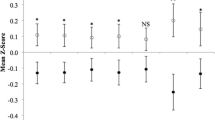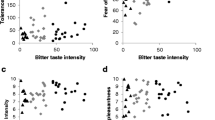Abstract
Thermal modulation of signaling pathways leads to excitation of taste receptor cells, but the underlying mechanisms remain unclear. Furthermore, it has long been known that there are contrast effects in various senses. In this study, we investigated cold-taste contrast and the relationship between taste and somatosensation. We lowered intraoral temperature using cold stimulus as a pretreatment, then returned to normal temperature in 249 healthy subjects, before administering room temperature taste-stimulating solutions to investigate changes in sensitivity to the four basic tastes (Sweet, Salt, Sour, and Bitter). Statistical comparisons of taste recognition thresholds before and after cold stimulus showed increased taste sensitivity for all four basic tastes. After categorizing different levels of pre-cold stimulus taste sensitivity into groups and comparing changes in sensitivity to the four basic tastes before and after stimulus, we found that the lower the sensitivity to the four basic tastes, the greater the increase in sensitivity induced by cold stimulus. These findings suggest that taste and low temperature send afferent signals which cause interaction in the afferent pathways between the peripheral and central nervous systems. Cold stimulus may offer one possible treatment strategy for dysgeusia.


Similar content being viewed by others
References
Zotterman Y. Action potentials in the glossopharyngeal nerve and in the chorda tympani. Skand Arch Physiol. 1935;72:73–7.
McBuney DH, Collings VB, Glanz LM. Temperature dependence of human taste responses. Physiol Behav. 1973;11:89–94.
Bartoshuk LM, Rennert K, Podin J, Stevens JC. Effects of temperature on the perceived sweetness of sucrose. Physiol Behav. 1982;28:905–10.
Oakley B. Taste responses of human chorda timpani nerve. Chem Senses. 1985;10:469–81.
Calviño AM. Perception of sweetness: the effects of concentration and temperature. Physiol Behav. 1986;36:1021–8.
Green BG, Gelhard B. Perception of temperature on oral and facial skin. Somatosens Res. 1987;4:191–200.
Green BG, Frankmann SP. The effect of cooling the tongue on the perceived intensity of taste. Chem Senses. 1987;12:609–19.
Cruz A, Green BG. Thermal stimulation of taste. Nature. 2000;403:889–92.
Pėrez CA, Huang L, Rong M, Kozak JA, Preuss AK, Zhang H, Max M, Margolskee RF. A transient receptor potential channel expressed in taste receptor cells. Nature Neurosci. 2002;5:1169–76.
Zhang Y, Hoon MA, Chandrashekar J, Mueller KL, Cook B, Wu D, Zuker CS, Ryba NJ. Coding of sweet, bitter, and umami tastes: different receptor cells sharing similar signaling pathways. Cell. 2003;112:293–301.
Damak S, Rong M, Yasumatsu K, Kokrashvili Z, Pérez CA, Shigemura N, Yoshida R, Mosinger B, Glendinning J, Ninomiya Y, et al. Trpm5 null mice respond to bitter, sweet, and umami compounds. Chem Senses. 2006;31:253–64.
Talavera K, Ninomiya Y, Winkel C, Voets T, Nilius B. Influence of temperature on taste perception. Cell Mol Life Sci. 2007;64:377–81.
Talavera K, Yasumatsu K, Voets T, Droogmans G, Shigemura N, Ninomiya Y, Margolskee RF, Nilius B. Heat activation of TRPM5 underlies thermal sensitivity of sweet taste. Nature. 2005;438:1022–5.
Ackerman BH, Kasbekar N. Disturbances of taste and smell induced by drugs. Pharmacotherapy. 1997;17:482–96.
Heckmann SM, Hujoel P, Hobiger S, Friess W, Wichmann M, Heckmann JG, Hummel T. Zinc gluconate in the treatment of dysgeusia-a randomized clinical trial. J Dent Res. 2005;84:35–8.
Woodhouse JM, Barlow HB. Spatial and temporal resolution and analisis. In: Barlow HB, Mollon JD, editors. The senses. Cambridge: Cambridge University Press; 1982. p. 132–64.
Pfaffmann C, Bartoshuk LM, McBurney DH. Chapter 5 taste psychophysics. In: Beidler LM, editor. Handbook of Sensory Physiology, vol. IV., Chemical senses part 2 tasteBerlin Heidelberg New York: Springer-Verlag; 1971. p. 76–101.
Schöbel N, Kyereme J, Minovi A, Dazert S, Bartoshuk L, Hatt H. Sweet taste and chorda tympani transection alter capsaicin-induced lingual pain perception in adult human subjects. Physiol Behav. 2012;107:368–73.
Fujiyama R, Ishitobi S, Honda K, Okada Y, Oi K, Toda K. Ice cube stimulation helps to improve dysgeusia. Odontology. 2010;98:82–4.
Kiesow F. Beiträge zur Physiologischen Psychologie des Geschmackssinnes. Phyl Stud. 1894;10:523–61 (1896;12:255–278).
Abe J, Hosokawa H, Okazawa M, Kandachi M, Sawada Y, Yamanaka K, Matsumura K, Kobayashi Y. TRPM8 protein localization in trigeminal ganglion and taste papillae. Mol Brain Res. 2005;136:91–8.
Yajima T, Sato T, Hosokawa H, Kondo T, Saito M, Shimauchi H, Ichikawa H. Distribution of transient receptor potential melastatin-8-containing nerve fibers in rat oral and craniofacial structures. Ann Anat. 2015;201:1–5.
Sperling W, Biermann T, Spannenberger R, Clepce M, Padberg F, Reulbach U, Kornhuber J, Thuerauf N. Changes in gustatory perceptions of patients with major depression treated with vagus nerve stimulation (VNS). Pharmacopsychiatry. 2011;44:67–71.
Green BG, Nachtigal D. Somatosensory factors in taste perception: effects of active tasting and solution temperature. Physiol Behav. 2012;107:488–95.
Green BG, Nachtigal D. Temperature affects human sweet taste via at least two mechanisms. Chem Senses. 2015;40:391–9.
Eddy MC, Eschle BK, Peterson D, Lauras N, Margolskee RF, Delay ER. A conditioned aversion study of sucrose and SC45647 taste in TRPM5 knockout mice. Chem Senses. 2012;37:391–401.
Zhang Z, Zhao Z, Margolskee R, Liman E. The transduction channel TRPM5 is gated by intracellular calcium in taste cells. J Neurosci. 2007;27:5777–86.
Acknowledgments
This work was supported by KAKENHI Grant #25463112 for Scientific Research from the Japan Society for the Promotion of Science to R.F.
Author information
Authors and Affiliations
Corresponding author
Ethics declarations
Conflict of interest
The authors declare that they have no conflict of interest.
Rights and permissions
About this article
Cite this article
Fujiyama, R., Toda, K. Functional effects of cold stimulation on taste perception in humans. Odontology 105, 275–282 (2017). https://doi.org/10.1007/s10266-016-0263-4
Received:
Accepted:
Published:
Issue Date:
DOI: https://doi.org/10.1007/s10266-016-0263-4




